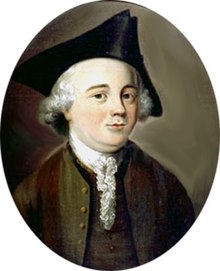
Back جون كاى (مخترع من مملكه بريطانيا العظمى) ARZ John Kay Catalan John Kay (Erfinder) German John Kay Esperanto John Kay Spanish John Kay (lentävä sukkula) Finnish John Kay (inventeur) French John Kay Irish John Kay Italian ジョン・ケイ (飛び杼) Japanese
John Kay | |
|---|---|
 | |
| Born | 17 June (N.S 28 June) 1704[4] Walmersley, Bury, Lancashire, England |
| Died | c. 1779[5][6][7] France |
| Nationality | English |
| Occupation | Inventor |
| Known for | Flying shuttle |
| Spouse | Anne Holte[8] |
| Children | Lettice, Robert (drop box inventor), Ann, Samuel, Lucy, James, John, Alice, Shuse, William, (and two other children who died in childhood)[9] |
| Parent(s) | Robert Kay and Ellin Kay, née Entwisle |

John Kay (17 June 1704 – c. 1779) was an English inventor whose most important creation was the flying shuttle, which was a key contribution to the Industrial Revolution. He is often confused with his namesake,[10][11] who built the first "spinning frame".[12]
- ^ "Science and Society Picture Library".
- ^ John Ainsworth (b. 1777) says in his book Walks around Bury (1842) that he saw this picture in 1842, and that it appeared to show the inventor's son who he knew "very well". Although Ainsworth knew the son as an old man, and could not have met the inventor himself, Lord (1903) wrote that this "settles the question of doubt as regards the portraits which Lieut.-Col. Sutcliffe put into circulation as a portrait of his great-grandfather" (the fly-shuttle inventor) because Ainsworth is a more reliable source than Sutcliffe, who originated the claim that the elder John Kay is pictured. Lord (page 92) states, "It was the inventor’s son John, who obtained the name “Frenchman Kay.” This description of the son by Canon Raines is confirmation of the identity of the portraits (where the three-cornered hat and French garb are in evidence), and these were as “Veritas” described them, portraits of John Kay the son, who married Elizabeth Lonsdall."
- ^
Mann, J. de L. (January 1931). "XXII: The introduction of the fly shuttle". The cotton trade and industrial Lancashire, 1600–1780. Vol. Book V. Manchester University Press. p. 449. ASIN B0006ALG3Y.
This son was known in later life in Bury as "Frenchman Kay," and the portrait supposed to be that of the inventor is really his.
As well as the identification of the sitter given by John Ainsworth, the "French" clothing and tricorne were characteristic of "Frenchman" John Kay in 1790s Bury (where he was considered a "fop" -see Lord (1903) pages 91–92). - ^ Lord, John (1903). "IV: Documentary Evidence of Descent". Memoir of John Kay. J. Clegg. p. 79. ISBN 978-1-150-68477-7. OCLC 12536656.
- ^ Cite error: The named reference
bio1998was invoked but never defined (see the help page). - ^ J. B. Thompson's 1964 summary in The achievements of Western civilisation says "date of death unknown". Nobody has yet found exact records or year of his death, though all sources agree it occurred in France between 1764 and 1780. His final year is often given as 1764 (for instance, by the London Science Museum) and often as 1780 (e.g. the BBC's History of the world gives a 1780 death date in the South of France at age 76). Lord (1903) was skeptical that Kay reached 70. And, in the Bury Times (27 December 1902) Lord wrote "The death of John Kay, in Paris, occurred in 1767 or 1768" (see: Bygone Bury p. 108). Lord acknowledges that no Paris death registration exists for John Kay between 1750 and 1770, but says that this is because "documents of all kinds were destroyed during the Commune revolutionary days" —see Lord (1903) p. 169. Mann (1931) reports a July 1779 letter from Kay (largely ruling out earlier dates) but says that he very probably died shortly after the letter was written and that the author of Thoughts on the Use of Machines (1780, probably Dorning Rasbotham) makes a "natural error" in writing that Kay was still alive in 1780.
- ^ Cite error: The named reference
endwas invoked but never defined (see the help page). - ^ Lord, J. (1903). "VI: John Kay, Inventor of the Fly-Shuttle". Memoir of John Kay. p. 96. OCLC 12536656.
He married in 1725, Anne, the daughter of John Holte, probably a near neighbour, and set up housekeeping at Park.
- ^ Cite error: The named reference
kids12was invoked but never defined (see the help page). - ^ Kay, J. (2 January 2003). "Weaving the fine fabric of success". Financial Times. Retrieved 2 June 2010.
technological progress is equally dependent on skills of invention and the management of invention
(John Kay's essay on the two John Kays of the Industrial Revolution). - ^ Cite error: The named reference
confusionwas invoked but never defined (see the help page). - ^ Espinasse, F. (1874). Lancashire worthies. Simpkin, Marshall, & Co. OCLC 10973235. "who has not the slightest connection with John Kay, the inventor of the fly-shuttle" (p. 330)... "John Kay, a watchmaker, who is not for a moment to be confounded with John Kay of Bury, the undoubted inventor of the fly-shuttle" (p. 378)